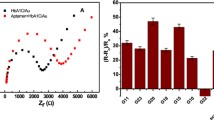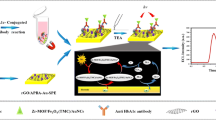Abstract
A micro FET-based immunosensor was developed for the determination of hemoglobin-A1c (HbA1c). The HbA1c/hemoglobin ratio is an important index in diabetes control. The sensor was fabricated by Complementary Metal-Oxide-Semiconductor Transistor (CMOS) and Micro Electronic Mechanical System (MEMS) techniques. The antibodies were immobilized via mixed self-assembled monolayers (SAMs) on a gold nanofilm. The nanofilm was deposited on a gold electrode by seed-mediated growth and gave a uniform and well distributed coverage. Nonspecific sites and interferences by noise were eliminated by covering the AuNPs with mixed SAMs. Compared to the immunosensor fabricated via the mixed SAMs method without gold nanofilm, the immunosensor displays a more than 2-fold sensitivity. The immunosensor is capable of detecting HbA1c and hemoglobin in hemolyzed and diluted whole blood, and results showed good agreement with the established clinical method.

Based on CMOS and MEMS techniques, a micro FET-based immunosensor was developed for the hemoglobin-A1c level determination. The antibodies were immobilized based on the mixed self-assembled monolayers and seed-mediated growth method. The immunosensor can detect HbA1c and hemoglobin simultaneously and has good potential for clinical application.






Similar content being viewed by others
References
American Diabetes Association (2003) Standards of medical care for patients with diabetes mellitus. Diabetes Care 26:s33–s50. doi:10.2337/diacare.26.2007.S33
Scognamiglio V, Pezzotti G, Pezzotti I, Cano J, Buonasera K, Giannini D, Giardi MT (2010) Microchim Acta 170:215–225. doi:10.1007/s00604-010-0313-5
Tang D, Xia B (2007) Electrochemical immunosensor and biochemical analysis for carcinoembryonic antigen in clinical diagnosis. Microchim Acta 163:41–48. doi:10.1007/s00604-007-0918-5
Fang L, Li W, Zhou Y et al (2009) A single-use, disposable iridium-modified electrochemical biosensor for fructosyl valine for the glycoslated hemoglobin detection. Sens Actuators B: Chem 137:235–238. doi:10.1016/j.snb.2008.09.045
Anzai J, Hashimoto J, Osa T et al (1988) Sensors based on an ion-sensitive field-effect transistor coated with stearic acid Langmuir–Blodgett membrane. Anal Sci 4:247–250. doi:10.2116/analsci.4.247
Wan K, Chovelon JM, Jaffrezic-Renault N (2000) Enzyme-octadecylamine Langmuir–Blodgett membranes for ENFET biosensors. Talanta 52:663–670. doi:10.1016/S0039-9140(00)00407-0
Feng CL, Xu YH, Song LM (2000) Study on highly sensitive potentiometric IgG immunosensor. Sens Actuators B: Chem 66:190–192. doi:10.1016/S0925-4005(00)00382-8
Kamahori M, Lshige Y, Shimoda M (2007) A novel enzyme immunoassay based on potentiometric measurement of molecular adsorption events by an extended-gate field-effect transistor sensor. Biosens Bioelectron 22:3080–3085. doi:10.1016/j.bios.2007.01.011
Qu L, Xia S, Bian C et al (2009) A micro-potentiometric hemoglobin immunosensor based on electropolymerized polypyrrole–gold nanoparticles composite. Biosens Bioelectron 24:3419–3424. doi:10.1016/j.bios.2008.07.077
Lei CX, Gong FC, Shen GL et al (2003) Amperometric immunosensor for Schistosoma japonicum antigen using antibodies loaded on a nano-Au monolayer modified chitosan-entrapped carbon paste electrode. Sens Actuators B: Chem 96:582–588. doi:10.1016/j.snb.2003.06.001
An HZ, Yuan R, Tang DP et al (2007) Dual-amplification of antigen–antibody interactions via backfilling gold nanoparticles on (3-mercaptopropyl) trimethoxysilane sol–gel functionalized interface. Electroanalysis 19:479–486. doi:10.1002/elan.200603752
Cai H, Shang C, Hsing IM (2004) Sequence-specific electrochemical recognition of multiple species using nanoparticle labels. Analytica Chimica Acta 523:61–68. doi:10.1016/j.aca.2004.06.072
Long Y, Nie L, Chen JH et al (2003) Piezoelectric quartz crystal impedance and electrochemical impedance study of HSA–diazepam interaction by nanogold-structured sensor. J Colloid Interface Sci 263:106–112. doi:10.1016/S0021-9797(03)00141-3
Carralero Sanz V, Luz Mena M, González-Cortés A et al (2005) Development of a tyrosinase biosensor based on gold nanoparticles-modified glassy carbon electrodes: Application to the measurement of a bioelectrochemical polyphenols index in wines. Anal Chim Acta 528:1–8. doi:10.1016/j.aca.2004.10.007
Zhang S, Wang N, Yu H et al (2005) Covalent attachment of glucose oxidase to an Au electrode modified with gold nanoparticles for use as glucose biosensor. Bioelectrochemistry 67:15–22. doi:10.1016/j.bioelechem.2004.12.002
Wu BY, Hou SH, Yin F et al (2007) Amperometric glucose biosensor based on layer-by-layer assembly of multilayer films composed of chitosan, gold nanoparticles and glucose oxidase modified Pt electrode. Biosens Bioelectron 22:838–844. doi:10.1016/j.bios.2006.03.009
Odenthal KJ, Gooding JJ (2007) An introduction to electrochemical DNA biosensors. Analyst 132:603–610. doi:10.1039/B701816A
Liu B, Lu L, Li Q, Xie G (2011) Disposable electrochemical immunosensor for myeloperoxidase based on the indium tin oxide electrode modified with an ionic liquid composite film containing gold nanoparticles, poly(o-phenylenediamine) and carbon nanotubes. Microchim Acta 173:513–520. doi:10.1007/s00604-011-0575-6
Tang D, Xia B, Zhang Y (2008) Direct electrochemistry and electrocatalysis of hemoglobin in a multilayer {nanogold=PDDA}n inorganic–organic hybrid film. Microchim Acta 160:367–374. doi:10.1007/s00604-007-0840-x
Jiang DC, Tang J, Liu BH (2003) Covalently coupling the antibody on an amine-self-assembled gold surface to probe hyaluronan-binding protein with capacitance measurement. Biosens Bioelectron 18:1183–1191. doi:10.1016/S0956-5663(02)00253-1
Mirsky VM, Riepl M, Wolfbeis OS (1997) Capacitive monitoring of protein immobilization and antigen-antibody reactions on monomolecular alkylthiol films on gold electrodes. Biosens Bioelectron 12:977–989. doi:10.1016/S0956-5663(97)00053-5
Pillay J, Ozoemena KI (2009) Layer-by-layer self-assembled nanostructured phthalocyaninatoiron(II)/SWCNT-poly(m-aminobenzenesulfonic acid) hybrid system on gold surface: Electron transfer dynamics and amplification of H2O2 response. Electrochim Acta 54:5053–5059. doi:10.1016/j.electacta.2008.12.056
Mena ML, Yáñez-Sedeño P, Pingarrón JM (2005) A comparison of different strategies for the construction of amperometric enzyme biosensors using gold nanoparticle-modified electrodes. Anal Biochem 336:20–27. doi:10.1016/j.ab.2004.07.038
Xu S, Peng B, Han X (2007) A third-generation H2O2 biosensor based on horseradish peroxidase-labeled Au nanoparticles self-assembled to hollow porous polymeric nanopheres. Biosens Bioelectron 22:1807–1810. doi:10.1016/j.bios.2006.07.008
Oyama M (2010) Recent nanoarchitectures in metal nanoparticle-modified electrodes for electroanalysis. Anal Sci 26:1–12. doi:10.2116/analsci.26.1
Bergveld P (2003) Thirty years of ISFETOLOGY: What happened in the past 30 years and what may happen in the next 30 years. Sens Actuators B: Chem 88:1–20. doi:10.1016/S0925-4005(02)00301-5
Fähnrich KA, Pravda M, Guilbault GG (2001) Recent applications of electrogenerated chemiluminescence in chemical analysis. Talanta 54:531–559. doi:10.1016/S0039-9140(01)00312-5
Acknowledgment
This work is supported by the National Basic Research Program of China (973 Program) (Project Number 2009CB320300).
Author information
Authors and Affiliations
Corresponding author
Electronic supplementary material
Below is the link to the electronic supplementary material.
Esm 1
(DOC 135 kb)
Rights and permissions
About this article
Cite this article
Xue, Q., Bian, C., Tong, J. et al. FET immunosensor for hemoglobin A1c using a gold nanofilm grown by a seed-mediated technique and covered with mixed self-assembled monolayers. Microchim Acta 176, 65–72 (2012). https://doi.org/10.1007/s00604-011-0675-3
Received:
Accepted:
Published:
Issue Date:
DOI: https://doi.org/10.1007/s00604-011-0675-3




